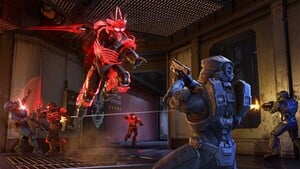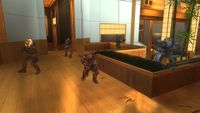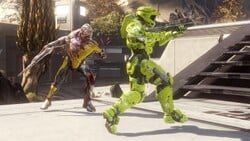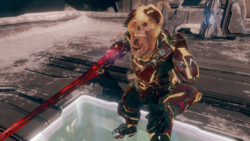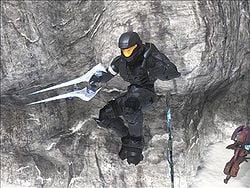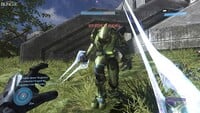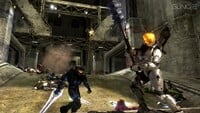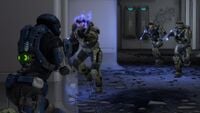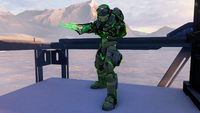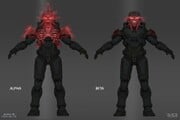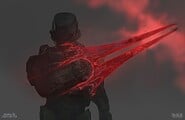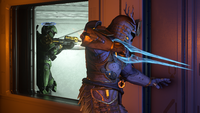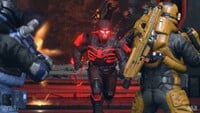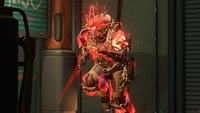Infection: Difference between revisions
From Halopedia, the Halo wiki
m (→Halo 4) |
|||
| (51 intermediate revisions by 23 users not shown) | |||
| Line 1: | Line 1: | ||
{{ | {{Status|Gameplay}} | ||
{{references}} | {{references}} | ||
{{Seealso|Infection Form}} | |||
[[File:HINF InfectionRender.jpg|thumb|300px|A render of an Infection match in ''Halo Infinite''.]] | |||
'''Infection''' is a [[multiplayer]] gametype in ''[[Halo 3]]'', ''[[Halo: Reach]]'', ''[[Halo 2: Anniversary]]'', ''[[Halo 5: Guardians]]'',<ref>[https://twitter.com/JoshingtonState/status/691129891601776640 '''Josh Holmes on Twitter''']</ref> and ''[[Halo Infinite]]''. It is the official [[Zombie]] mode, modelled after zombie mode's popularity as a custom game in ''[[Halo 2]]''.{{Ref/Site|Id=S4Infection|URL=https://www.halowaypoint.com/news/infection-overview-season-4|Site=Halo Waypoint|Page=INFECTION OVERVIEW <nowiki>|</nowiki> SEASON 4|D=17|M=06|Y=2023}} In ''[[Halo 4]]'', the gametype was tweaked and renamed [[Flood (gametype)|Flood]]. | |||
==Description== | |||
[[File:Infection Symbol.svg|thumb | [[File:Infection Symbol.svg|thumb|Infection Emblem.]] | ||
[[File:infectionmedals.png|thumb | [[File:infectionmedals.png|thumb|Infection Medals.]] | ||
Players in Infection matches are split into two teams: the Survivors and the Zombies. When a survivor dies, they switch to the zombie team. A survivor's goal is to remain alive (i.e. "uninfected") until the end of the round, while a zombie's goal is to kill (infect) as many survivors as possible. When only one survivor remains, that survivor becomes the "Last Man Standing." The Last Man Standing can be given unique player traits; typically, these include a waypoint revealing their location to zombies, making survival an extreme challenge. | |||
The players who start a round as zombies are Alpha Zombies. The number of Alpha Zombies can be changed in the gametype options, and Alpha Zombies can be given unique player traits to distinguish them from standard zombies. | |||
The | |||
Typically, the zombies have melee weapons at their disposal and are capable of killing survivors in a single blow. Survivors are given short- and medium-range firearms. | |||
==Medals== | ==Medals== | ||
*'''Zombie Killing Spree''' - Kill five zombies without dying. | *'''[[Zombie Killing Spree]]''' - Kill five zombies without dying. | ||
*'''Hell's Janitor''' - Kill ten zombies without dying. | *'''[[Hell's Janitor]]''' - Kill ten zombies without dying. | ||
*'''Hell's Jerome''' - Kill fifteen zombies without dying. <small>(Not in Halo 3)</small> | *'''[[Hell's Jerome]]''' - Kill fifteen zombies without dying. <small>(Not in Halo 3)</small> | ||
*'''Infection Spree''' - Infect five humans without dying. | *'''[[Infection Spree]]''' - Infect five humans without dying. | ||
*'''Mmmm Brains''' - Infect ten humans without dying. | *'''[[Mmmm... Brains]]''' - Infect ten humans without dying. | ||
*'''Thriller''' - Infect fifteen humans without dying. <small>(Not in Halo 3)</small> | *'''[[Thriller]]''' - Infect fifteen humans without dying. <small>(Not in Halo 3)</small> | ||
*'''Last Man Standing''' - Be the last human left alive in the round. | *'''[[Last Man Standing]]''' - Be the last human left alive in the round. | ||
==History by game== | |||
===''Halo 2''=== | |||
{{Main|Zombies}} | |||
While it was yet to be implemented as an official mode, Infection—simply called "[[Zombies]]"—first existed as a custom game played with honor rules in ''[[Halo 2]]''. In its original form, the Red Team were the humans and the Green Team were the Energy Sword-wielding zombies. Players would have to manually switch teams using the pause menu if they were killed by a zombie to join the infected. The maps [[Foundation]] and [[Headlong]] were particularly popular choices for this mode.{{Ref/Reuse|S4Infection}} | |||
In 2023 it was discovered that Halo 2 once had an official internal version of Infection in development, among [[Cut Halo 2 gamemodes|other cut gametypes]]. This version of Infection featured team changing behavior similar to that found in the eventual Halo 3 variant, however was never released during Halo 2's tenure on Xbox Live. Files and further information about the modes were released through the [[Digsite]] project in 2024.{{Ref/Twitter|Id=Neo1|neoteaika|1750096246759678109|Neo Te Aika|Quote=Cool #Halo 2-Digsiteish thing I got permission to share! 🧵<br>Halo 2 once had more gametypes, including Infection & VIP (later appearing in Halo 3), Headhunter (Reach), and Medic (don't think we fully figured this one out)...<br>(glitchy HUD is a side effect of H2 Uncut dev tags)|D=26|M=01|Y=2024}} | |||
== | ===''Halo 3''=== | ||
Infection was introduced as an official mode in ''[[Halo 3]]''. While it was playable on-disc from launch day, it did not appear in Matchmaking until [[2007#October|October 31, 2007]] when a special Halloween playlist was introduced. This playlist permitted up to 13 players (it being [[wikipedia:13 (number)#Unlucky 13|an "unlucky" number]]) to play Infection. It was wildly popular and eventually became a frequently-recurring Double EXP Weekend playlist: [[Living Dead]]. Living Dead was ranked when it appeared on Halloween, and social on other occasions It offered a number of Infection gametypes, including "[[Save One Bullet]]" and "Brains." | |||
Infection games also appeared in other Double EXP playlists such as Turkey Day, the [[2008]] Thanksgiving weekend playlist. | |||
===Halo: Reach=== | ===''Halo: Reach''=== | ||
[[File:InfectionHumans.jpg|thumb|Human players holding a position in Infection.]] | [[File:InfectionHumans.jpg|thumb|Human players holding a position in Infection.]] | ||
''[[Halo: Reach]]'' introduced the [[Safe Haven]]s feature; maps had to be compatible with Safe Havens in order to support any Infection game variant, even when the Havens feature was disabled. ''Reach'' also introduced the "rebalancing" feature: if a zombie quit a match, a survivor would be forcibly converted to a zombie. ''Reach'' did not offer the Alpha Zombie feature on launch; it also did not offer the "Next Zombie" option due to technical limitations. | |||
While Zombie Traits could be configured as normal, zombies' starting loadouts were harder to find: you had to edit the "Elite Loadouts" normally used for Invasion. | |||
In the default Infection settings, zombies had the Evade [[armor ability]], a higher movement speed, and lower gravity, which allowed them to rapidly approach survivors so long as they did not jump; conversely, they had no shields, making them constantly vulnerable to headshots. Survivors spawned with both shotguns and magnums, but weapon pickup was disabled, leaving them unable to acquire more ammo; even when they ran out of ammo, they could sometimes survive using sword block, a game mechanic unique to ''Reach''. The default Safe Havens settings differed only slightly from Infection: survivors' damage output was reduced by half when outside of a haven, and survivors were granted invulnerability and standard damage output while inside of a haven. In May 2011, Bungie released an Infection game variant that implemented the Alpha Zombie feature; this variant's default settings gave Alpha Zombies unlimited sprint and forced color (red armor). | |||
''Halo: Reach'' offered Living Dead as a standard playlist available from launch day. Changes to Infection's settings and gametype script were distributed through this playlist; players who wanted to experiment with Alpha Zombies had to play the variant in Matchmaking and then save it from their Temporary History. Small changes were made to Infection's settings over time; for example, zombies had their gravity increased to normal and their jump height increased, to allow them to jump higher without being "floaty" and excessively vulnerable in mid-air. For the most part, though, Living Dead maintenance focused on patching the most egregious exploits in the playlist's maps, the overwhelming majority of which were not designed or significantly customized with Infection gameplay in mind. | |||
''Halo: Reach'' introduced three notable bugs; one of these was mitigated in Matchmaking, but none of them were ever truly fixed: | |||
*If players were given limited lives and all zombies ran out of lives, the round wouldn't end properly. Infection's special round-end conditions (all survivors dead) still functioned, but otherwise, Infection was technically an FFA gametype and so used FFA round-end conditions. As such, in variants with limited lives, a round would only end if all zombies and all but one survivor ran out of lives. This meant that many popular Custom Games, such as Duck Hunt, had to be built "backwards," with the hunter implemented as a lone survivor and the prey as zombies. | |||
*A [[wikipedia:Race condition|race condition]] would often occur when a survivor and a zombie traded kills in close quarters: the kills would sometimes register ''after'' the survivor changed teams, leading the game to count one of the kills as a betrayal. In many cases, the killed survivor would be given the option to boot, and vengeful players would often make use of that option. This is why Betrayal Booting was removed from the Living Dead playlist. It is not known how the later removal of Friendly Fire from the playlist affected this bug. | |||
*A player's team assignment would often desynchronize from the server when they joined games in progress. New players would spawn as survivors, but they would appear as enemies to fellow survivors: the players already present would see the new player's gamertag in red and even gain aim assist on them. | |||
===''Halo 4''=== | |||
{{Main|Flood (gametype)}} | |||
[[File:Flood 1 (gametype).jpg|thumb|right|250px|A Flood player lunges at a survivor.]] | |||
Released with the launch of ''[[Halo 4]]'', Flood was marketed as a successor to Infection, though the core gameplay remained largely identical and it is generally simply considered to be a variant of the Infection mode. In Flood, players are split into a Survivor team and a Flood team, and survivors must avoid being killed and converted to the Flood team. The principal difference between Flood and Infection is the addition of a new player model for the Flood: an infected Spartan's body was stripped of its hard armor plating and covered in a [[Flood]] carapace. Altered settings also gave Flood players a special armor effect that trailed behind them and a first-person screen effect that distorted their vision. | |||
Flood featured several changes when compared to previous iterations of Infection: | |||
*Flood players did not spawn with weapons and couldn't pick any weapons up; they attacked using a fleshy claw that behaved similarly to the energy swords used in Infection. | |||
*Flood players were also incapable of sprinting. | |||
*The mode's default settings dictated that two players would start on the Flood team, and rounds would last for three minutes. | |||
*Flood players are equipped with energy shields, making it harder to kill them with headshots. Survivors would spawn with [[M45D Tactical Shotgun#M45D Tactical Shotgun|shotguns]] and [[M6H Personal Defense Weapon System|magnums]]. | |||
*Both teams had three loadouts to pick from, each of which offered a different armor ability. | |||
A new public variant called Hivemind was added on [[2013#July|July 1, 2013]]. In Hivemind, Spartans appeared in their chosen colors, instead of the default green. Survivors start with Assault Rifles and Magnums, and are able to pick up other weapons around the map, including Shotguns. It takes two hits from a Flood to kill a survivor. Neither side has Armor Abilities. | |||
===''Halo 2: Anniversary''=== | |||
[[File:H2A-InfectedSpartan.png|thumb|right|250px|A Flood-infected Spartan in ''Halo 2: Anniversary'' infection.]] | |||
Infection returned as an official mode in ''[[Halo 2: Anniversary]]'', offering a number of new features: | |||
*Zombies used a unique Flood-infected player model, similar to ''Halo 4''<nowiki/>'s [[Flood (gametype)|Flood]]. ''In Halo 2: Anniversary'', the Flood infection was mostly contained within a Spartan's armor, but Spartans' heads were severely mutilated by [[Pod infector]]s. | |||
*''Halo 2: Anniversary'' offered a unique Flood Energy Sword with a red hue, which was available in Forge and in game variant options. This weapon was designed specifically for use in Infection, and zombies were equipped with it by default. | |||
*Infection offered unique settings for variants such as Cadre and Flight. Cadre allowed survivors to receive special player traits as long as they remained near each other, while Flight tasked survivors with carrying a bomb around the map and arming it at specific locations. | |||
===''Halo 5: Guardians''=== | |||
Infection was added to ''[[Halo 5: Guardians]]'' as part of the [[Memories of Reach]] update. | |||
*Spartans start with a Shotgun and Assault Rifle with low ammunition. Other weapons can be found in the field. | |||
*Zombies use Energy Swords with a green tint and have a Pestilence effect. | |||
*Alpha Zombies now have partial Active Camouflage and do not appear on the motion sensor. | |||
*Both Spartans and Zombies can use boost thrusters, but Zombies cannot sprint. | |||
{{expand-section}} | |||
===''Halo Infinite''=== | |||
Infection was added to ''[[Halo Infinite]]'' with the release of [[Season 04: Infection]], a season themed extensively around the mode. A permanent Infection matchmaking playlist was introduced to the game at the start of the season.{{Ref/Reuse|S4Infection}}{{Ref/YouTube|Id=S4Live|mkTXZWFVUu0&t|HALO|Season 4: Infection Preview Livestream <nowiki>|</nowiki> Halo Infinite|D=17|M=06|Y=2023}} | |||
The mode is canonized in-universe as the [[Banished]]-aligned [[Smart AI|AI]] known as [[Iratus]] infecting the armor of trainees at the [[Avery J. Johnson Academy of Military Science]]. This is reflected in the [[Holography|holographic]] components added to infected Spartans' armor. Alpha Infected feature more over Iratus-themed holograms over their helmets and armor, while Beta Infected feature more subtle holographic elements. With default settings, all infected Spartans spawn with a unique red energy sword similar to a [[Bloodblade]]. The official multiplayer maps in ''Halo Infinite'' received variants with Infection-specific changes. The maps are overtaken with distortions and digital lightning to convey the theme of this incarnation of Infection, they have dead Spartans on the ground, new areas to hide, and other paths that might be blocked off by crates that could leave the player at a dead end.{{Ref/Reuse|S4Infection}}{{Ref/Reuse|S4Live}} | |||
==Tactics and | ''Halo Infinite''{{'}}s version of Infection also features some gameplay changes: | ||
[[File:Blemo Sword.jpg|thumb | *Survivors spawn with a [[VK78 Commando]] and a [[CQS48 Bulldog]], as well as several [[Threat Sensor]]s.{{Ref/Reuse|S4Live}} | ||
[[File:LastManCamper.jpg|thumb | *Alpha Infected retain the partial Active Camouflage from ''Halo 5: Guardians'' and they now also have several [[Shroud Screen]]s.{{Ref/Reuse|S4Live}} | ||
*If you are | *Maps may feature ammunition crates that allow survivors to replenish their ammo reserves.{{Ref/YouTube|Id=S4Trailer|DyvwxoRtfH0|HALO|Season 4: Infection Trailer <nowiki>|</nowiki> Halo Infinite|D=17|M=06|Y=2023}} | ||
* | |||
==Tactics and tips== | |||
[[File:Blemo Sword.jpg|thumb|250px|Zombies are often set to spawn with the classic Energy Sword.]] | |||
* | [[File:LastManCamper.jpg|thumb|250px|A player [[camping]] in an Infection game.]] | ||
* | *If you are building an Infection game, try to make it balanced. Consider giving the zombies 200% health and no shields, with a slightly higher speed and jump; in turn, try giving the survivors shotguns and pistols with limited ammo. When [[Forge|forging]] maps, be careful to make sure that survivors can't camp in a room with a single entrance; try and force the survivors to work together to guard a location. | ||
**It's often fun to barricade doors with movable or breakable items, such as barrels and pallets, when designing maps. | |||
*Survivors can work together to bait zombies into a trap, to earn more kills. Survivors can hole up in an easily-defended location, wait for zombie attacks to lull, and send out one player to serve as bait. The bait player would try to lure zombies into the base, where the zombies would be killed by overwhelming force. | |||
*In Halo 3, a survivor could escape infection and respawn elsewhere if they committed suicide while under attack. In ''Halo: Reach'', however, players that commit suicide will be infected. | |||
*Survivors should try to avoid using melee weapons against zombies unless they're very skilled with those weapons; zombies will also have melee weapons, so the odds of survival are generally about even. Zombies can afford to die; survivors cannot. | |||
*A team that regroups in a single area and holds their position in a well defensible location has a much higher chance of surviving. | *A team that regroups in a single area and holds their position in a well defensible location has a much higher chance of surviving. | ||
*Conserving ammunition is key in all Infection game types | *Conserving ammunition is key in all Infection game types. Most players tend to aim for the one spot where it will do the most damage, the head. However, even though zombies are vulnerable to headshots in most gametypes, the head is a small target and can be difficult to hit at range. Headshots use less ammo than body shots, but body shots use less ammo than repeatedly missing the head. | ||
*Never use Armor Lock in Infection. This only makes it easier for the zombies to swarm around you and wait until you pop back up for the kill. | |||
*Never use Armor Lock in | |||
*Try to avoid using attached turrets where possible, as they leave you unable to move and exposed from behind and to the sides. Only use turrets if you are sure that your team can hold your flanks. | *Try to avoid using attached turrets where possible, as they leave you unable to move and exposed from behind and to the sides. Only use turrets if you are sure that your team can hold your flanks. | ||
*It is common practice for survivors to camp at an exploitable part of the map, where they pick off zombies with relative ease. Though some of these areas have been eliminated from Matchmaking through updates, many remain that are simply normal areas of the map that are easy to reach but unbelievably hard to conquer when faced with a strong team of survivors. | |||
*It is common practice for survivors to camp at an exploitable part of the map, where they pick off zombies with relative ease. Though some of these areas have been eliminated through updates, many remain that are simply normal areas of the map that are easy to reach but unbelievably hard to conquer when faced with a strong survivors | |||
*Survivors are not able to pick up ammo, forcing them to pace their shots. In some cases, the last player gets infected before time runs out due to lack of ammo. | *Survivors are not able to pick up ammo, forcing them to pace their shots. In some cases, the last player gets infected before time runs out due to lack of ammo. | ||
==Trivia== | ==Trivia== | ||
*"Infection" is based on the popular custom gametype in ''Halo 2'' known as "zombies". Zombies was based on Team Slayer, with the Red team being humans and the Green team being zombies. The humans could only use human weapons, and the zombies could only use [[Energy Swords]]. The game began with just one or two zombie players, who would attempt to hunt down and kill the humans. When a human was killed by a zombie, they would have to change teams and become a zombie. Since there were no facilities in ''Halo 2'' Custom Games to limit what weapons each team could use or to force players to switch teams upon death, zombie gametypes relied on honor rules. | *"Infection" is based on the popular custom gametype in ''Halo 2'' known as "zombies". Zombies was based on Team Slayer, with the Red team being humans and the Green team being zombies. The humans could only use human weapons, and the zombies could only use [[Energy Swords]]. The game began with just one or two zombie players, who would attempt to hunt down and kill the humans. When a human was killed by a zombie, they would have to change teams and become a zombie. Since there were no facilities in ''Halo 2'' Custom Games to limit what weapons each team could use or to force players to switch teams upon death, zombie gametypes relied on honor rules. | ||
* | *Halo 3's [[Mythic Map Pack]] introduced Achievements specifically for Infection: [[Delicious Brains]] was awarded to zombies who infected two survivors during a round, and [[Zombie Repeller]] was awarded to survivors who killed two zombies during a round. | ||
* | *In ''Halo: Reach'' Custom Games, the Safe Havens feature was used to create Infection maps that put players on a linear progression: survivors had to traverse a linear path, such as a series of city streets, and reach a Haven placed at the end of the map to win; zombies spawned at a central hub and could use teleporters to access any part of the path. This gameplay was enforced by only crediting survivors for kills scored from inside of a Safe Haven. It was common for settings to be tweaked so that survivors took two or three hits to kill, but did not regenerate their shields or health without the use of a [[health pack]]. | ||
*It is possible for a survivor to acquire an Energy Sword in ''Halo: Reach'', as seen [http://www.youtube.com/watch?v=PZkGYMyqGa4 here]. For this to happen, a host migration must occur right as a survivor is infected and respawns as a zombie. When the game starts again, there's a chance that the player will turn back into a survivor, but will keep the zombie loadout. | |||
*It is possible for a | |||
==Gallery== | |||
<gallery> | |||
File:H3 Isolation Swords.jpg|First-person view of an infected player in ''Halo 3''. | |||
File:H3 Isolation Infection.jpg|First-person view of a player pursued by infected players in ''Halo 3''. | |||
File:H3 RatsNest Infection.jpg|An infected player approaches a player from behind in ''Halo 3''. | |||
File:HTMCC-HR Infection Sword Base.jpg|Three infected players approaching a player in ''Halo: Reach''. | |||
File:H5G-Infected.png|An infected player in ''Halo 5: Guardians''. | |||
File:H5G-InfectedSwordHUD.png|The HUD of an infected player in ''Halo 5: Guardians''. | |||
File:H5G-Infection.png|A match of Infection in ''Halo 5: Guardians''. | |||
File:HINF Concept Infection.jpg|Concept art of Infection in ''Halo Infinite''. | |||
File:HINF Concept AlphaBetaInfected.jpg|Concept art of the different holographic effects for Alpha and Beta Infected in ''Halo Infinite''. | |||
File:HINF Concept InfectedSword.jpg|Concept art of the unique Infected energy sword in ''Halo Infinite''. | |||
File:HINF-GlitchedInfection.png|A glitched game of Infection during the [[Winter Update]] in ''Halo Infinite''. | |||
File:HINF-S4InfectionSpartans.jpg|An Infected Alpha charging at two Survivors in ''Halo Infinite''. | |||
File:HINF-DoubleInfectedSpartan.png|An Infected Alpha with Flood cosmetics on [[Streets]]. | |||
</gallery> | |||
==Sources== | ==Sources== | ||
{{Ref/Sources}} | |||
== | ==See also== | ||
*[[Alpha Zombie]] | |||
*[[Flood (gametype)]] | |||
*[[Custom game]]s | *[[Custom game]]s | ||
{{ | {{Gametype}} | ||
[[Category:Multiplayer]] | [[Category:Multiplayer gametypes]] | ||
[[Category:Halo 3 gametypes]] | |||
[[Category:Halo: Reach gametypes]] | |||
[[Category:Halo 2: Anniversary multiplayer gametypes]] | |||
[[Category:Halo 5: Guardians gametypes]] | |||
Latest revision as of 05:00, August 12, 2024
| This article does not have enough inline citations and/or does not adhere to the proper citation format. You can help Halopedia by adding citations. |
Infection is a multiplayer gametype in Halo 3, Halo: Reach, Halo 2: Anniversary, Halo 5: Guardians,[1] and Halo Infinite. It is the official Zombie mode, modelled after zombie mode's popularity as a custom game in Halo 2.[2] In Halo 4, the gametype was tweaked and renamed Flood.
Description[edit]
Players in Infection matches are split into two teams: the Survivors and the Zombies. When a survivor dies, they switch to the zombie team. A survivor's goal is to remain alive (i.e. "uninfected") until the end of the round, while a zombie's goal is to kill (infect) as many survivors as possible. When only one survivor remains, that survivor becomes the "Last Man Standing." The Last Man Standing can be given unique player traits; typically, these include a waypoint revealing their location to zombies, making survival an extreme challenge.
The players who start a round as zombies are Alpha Zombies. The number of Alpha Zombies can be changed in the gametype options, and Alpha Zombies can be given unique player traits to distinguish them from standard zombies.
Typically, the zombies have melee weapons at their disposal and are capable of killing survivors in a single blow. Survivors are given short- and medium-range firearms.
Medals[edit]
- Zombie Killing Spree - Kill five zombies without dying.
- Hell's Janitor - Kill ten zombies without dying.
- Hell's Jerome - Kill fifteen zombies without dying. (Not in Halo 3)
- Infection Spree - Infect five humans without dying.
- Mmmm... Brains - Infect ten humans without dying.
- Thriller - Infect fifteen humans without dying. (Not in Halo 3)
- Last Man Standing - Be the last human left alive in the round.
History by game[edit]
Halo 2[edit]
- Main article: Zombies
While it was yet to be implemented as an official mode, Infection—simply called "Zombies"—first existed as a custom game played with honor rules in Halo 2. In its original form, the Red Team were the humans and the Green Team were the Energy Sword-wielding zombies. Players would have to manually switch teams using the pause menu if they were killed by a zombie to join the infected. The maps Foundation and Headlong were particularly popular choices for this mode.[2]
In 2023 it was discovered that Halo 2 once had an official internal version of Infection in development, among other cut gametypes. This version of Infection featured team changing behavior similar to that found in the eventual Halo 3 variant, however was never released during Halo 2's tenure on Xbox Live. Files and further information about the modes were released through the Digsite project in 2024.[3]
Halo 3[edit]
Infection was introduced as an official mode in Halo 3. While it was playable on-disc from launch day, it did not appear in Matchmaking until October 31, 2007 when a special Halloween playlist was introduced. This playlist permitted up to 13 players (it being an "unlucky" number) to play Infection. It was wildly popular and eventually became a frequently-recurring Double EXP Weekend playlist: Living Dead. Living Dead was ranked when it appeared on Halloween, and social on other occasions It offered a number of Infection gametypes, including "Save One Bullet" and "Brains."
Infection games also appeared in other Double EXP playlists such as Turkey Day, the 2008 Thanksgiving weekend playlist.
Halo: Reach[edit]
Halo: Reach introduced the Safe Havens feature; maps had to be compatible with Safe Havens in order to support any Infection game variant, even when the Havens feature was disabled. Reach also introduced the "rebalancing" feature: if a zombie quit a match, a survivor would be forcibly converted to a zombie. Reach did not offer the Alpha Zombie feature on launch; it also did not offer the "Next Zombie" option due to technical limitations.
While Zombie Traits could be configured as normal, zombies' starting loadouts were harder to find: you had to edit the "Elite Loadouts" normally used for Invasion.
In the default Infection settings, zombies had the Evade armor ability, a higher movement speed, and lower gravity, which allowed them to rapidly approach survivors so long as they did not jump; conversely, they had no shields, making them constantly vulnerable to headshots. Survivors spawned with both shotguns and magnums, but weapon pickup was disabled, leaving them unable to acquire more ammo; even when they ran out of ammo, they could sometimes survive using sword block, a game mechanic unique to Reach. The default Safe Havens settings differed only slightly from Infection: survivors' damage output was reduced by half when outside of a haven, and survivors were granted invulnerability and standard damage output while inside of a haven. In May 2011, Bungie released an Infection game variant that implemented the Alpha Zombie feature; this variant's default settings gave Alpha Zombies unlimited sprint and forced color (red armor).
Halo: Reach offered Living Dead as a standard playlist available from launch day. Changes to Infection's settings and gametype script were distributed through this playlist; players who wanted to experiment with Alpha Zombies had to play the variant in Matchmaking and then save it from their Temporary History. Small changes were made to Infection's settings over time; for example, zombies had their gravity increased to normal and their jump height increased, to allow them to jump higher without being "floaty" and excessively vulnerable in mid-air. For the most part, though, Living Dead maintenance focused on patching the most egregious exploits in the playlist's maps, the overwhelming majority of which were not designed or significantly customized with Infection gameplay in mind.
Halo: Reach introduced three notable bugs; one of these was mitigated in Matchmaking, but none of them were ever truly fixed:
- If players were given limited lives and all zombies ran out of lives, the round wouldn't end properly. Infection's special round-end conditions (all survivors dead) still functioned, but otherwise, Infection was technically an FFA gametype and so used FFA round-end conditions. As such, in variants with limited lives, a round would only end if all zombies and all but one survivor ran out of lives. This meant that many popular Custom Games, such as Duck Hunt, had to be built "backwards," with the hunter implemented as a lone survivor and the prey as zombies.
- A race condition would often occur when a survivor and a zombie traded kills in close quarters: the kills would sometimes register after the survivor changed teams, leading the game to count one of the kills as a betrayal. In many cases, the killed survivor would be given the option to boot, and vengeful players would often make use of that option. This is why Betrayal Booting was removed from the Living Dead playlist. It is not known how the later removal of Friendly Fire from the playlist affected this bug.
- A player's team assignment would often desynchronize from the server when they joined games in progress. New players would spawn as survivors, but they would appear as enemies to fellow survivors: the players already present would see the new player's gamertag in red and even gain aim assist on them.
Halo 4[edit]
- Main article: Flood (gametype)
Released with the launch of Halo 4, Flood was marketed as a successor to Infection, though the core gameplay remained largely identical and it is generally simply considered to be a variant of the Infection mode. In Flood, players are split into a Survivor team and a Flood team, and survivors must avoid being killed and converted to the Flood team. The principal difference between Flood and Infection is the addition of a new player model for the Flood: an infected Spartan's body was stripped of its hard armor plating and covered in a Flood carapace. Altered settings also gave Flood players a special armor effect that trailed behind them and a first-person screen effect that distorted their vision.
Flood featured several changes when compared to previous iterations of Infection:
- Flood players did not spawn with weapons and couldn't pick any weapons up; they attacked using a fleshy claw that behaved similarly to the energy swords used in Infection.
- Flood players were also incapable of sprinting.
- The mode's default settings dictated that two players would start on the Flood team, and rounds would last for three minutes.
- Flood players are equipped with energy shields, making it harder to kill them with headshots. Survivors would spawn with shotguns and magnums.
- Both teams had three loadouts to pick from, each of which offered a different armor ability.
A new public variant called Hivemind was added on July 1, 2013. In Hivemind, Spartans appeared in their chosen colors, instead of the default green. Survivors start with Assault Rifles and Magnums, and are able to pick up other weapons around the map, including Shotguns. It takes two hits from a Flood to kill a survivor. Neither side has Armor Abilities.
Halo 2: Anniversary[edit]
Infection returned as an official mode in Halo 2: Anniversary, offering a number of new features:
- Zombies used a unique Flood-infected player model, similar to Halo 4's Flood. In Halo 2: Anniversary, the Flood infection was mostly contained within a Spartan's armor, but Spartans' heads were severely mutilated by Pod infectors.
- Halo 2: Anniversary offered a unique Flood Energy Sword with a red hue, which was available in Forge and in game variant options. This weapon was designed specifically for use in Infection, and zombies were equipped with it by default.
- Infection offered unique settings for variants such as Cadre and Flight. Cadre allowed survivors to receive special player traits as long as they remained near each other, while Flight tasked survivors with carrying a bomb around the map and arming it at specific locations.
Halo 5: Guardians[edit]
Infection was added to Halo 5: Guardians as part of the Memories of Reach update.
- Spartans start with a Shotgun and Assault Rifle with low ammunition. Other weapons can be found in the field.
- Zombies use Energy Swords with a green tint and have a Pestilence effect.
- Alpha Zombies now have partial Active Camouflage and do not appear on the motion sensor.
- Both Spartans and Zombies can use boost thrusters, but Zombies cannot sprint.
 This section needs expansion. You can help Halopedia by expanding it.
This section needs expansion. You can help Halopedia by expanding it.
Halo Infinite[edit]
Infection was added to Halo Infinite with the release of Season 04: Infection, a season themed extensively around the mode. A permanent Infection matchmaking playlist was introduced to the game at the start of the season.[2][4]
The mode is canonized in-universe as the Banished-aligned AI known as Iratus infecting the armor of trainees at the Avery J. Johnson Academy of Military Science. This is reflected in the holographic components added to infected Spartans' armor. Alpha Infected feature more over Iratus-themed holograms over their helmets and armor, while Beta Infected feature more subtle holographic elements. With default settings, all infected Spartans spawn with a unique red energy sword similar to a Bloodblade. The official multiplayer maps in Halo Infinite received variants with Infection-specific changes. The maps are overtaken with distortions and digital lightning to convey the theme of this incarnation of Infection, they have dead Spartans on the ground, new areas to hide, and other paths that might be blocked off by crates that could leave the player at a dead end.[2][4]
Halo Infinite's version of Infection also features some gameplay changes:
- Survivors spawn with a VK78 Commando and a CQS48 Bulldog, as well as several Threat Sensors.[4]
- Alpha Infected retain the partial Active Camouflage from Halo 5: Guardians and they now also have several Shroud Screens.[4]
- Maps may feature ammunition crates that allow survivors to replenish their ammo reserves.[5]
Tactics and tips[edit]
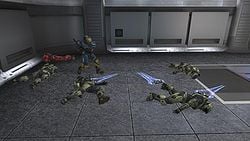
- If you are building an Infection game, try to make it balanced. Consider giving the zombies 200% health and no shields, with a slightly higher speed and jump; in turn, try giving the survivors shotguns and pistols with limited ammo. When forging maps, be careful to make sure that survivors can't camp in a room with a single entrance; try and force the survivors to work together to guard a location.
- It's often fun to barricade doors with movable or breakable items, such as barrels and pallets, when designing maps.
- Survivors can work together to bait zombies into a trap, to earn more kills. Survivors can hole up in an easily-defended location, wait for zombie attacks to lull, and send out one player to serve as bait. The bait player would try to lure zombies into the base, where the zombies would be killed by overwhelming force.
- In Halo 3, a survivor could escape infection and respawn elsewhere if they committed suicide while under attack. In Halo: Reach, however, players that commit suicide will be infected.
- Survivors should try to avoid using melee weapons against zombies unless they're very skilled with those weapons; zombies will also have melee weapons, so the odds of survival are generally about even. Zombies can afford to die; survivors cannot.
- A team that regroups in a single area and holds their position in a well defensible location has a much higher chance of surviving.
- Conserving ammunition is key in all Infection game types. Most players tend to aim for the one spot where it will do the most damage, the head. However, even though zombies are vulnerable to headshots in most gametypes, the head is a small target and can be difficult to hit at range. Headshots use less ammo than body shots, but body shots use less ammo than repeatedly missing the head.
- Never use Armor Lock in Infection. This only makes it easier for the zombies to swarm around you and wait until you pop back up for the kill.
- Try to avoid using attached turrets where possible, as they leave you unable to move and exposed from behind and to the sides. Only use turrets if you are sure that your team can hold your flanks.
- It is common practice for survivors to camp at an exploitable part of the map, where they pick off zombies with relative ease. Though some of these areas have been eliminated from Matchmaking through updates, many remain that are simply normal areas of the map that are easy to reach but unbelievably hard to conquer when faced with a strong team of survivors.
- Survivors are not able to pick up ammo, forcing them to pace their shots. In some cases, the last player gets infected before time runs out due to lack of ammo.
Trivia[edit]
- "Infection" is based on the popular custom gametype in Halo 2 known as "zombies". Zombies was based on Team Slayer, with the Red team being humans and the Green team being zombies. The humans could only use human weapons, and the zombies could only use Energy Swords. The game began with just one or two zombie players, who would attempt to hunt down and kill the humans. When a human was killed by a zombie, they would have to change teams and become a zombie. Since there were no facilities in Halo 2 Custom Games to limit what weapons each team could use or to force players to switch teams upon death, zombie gametypes relied on honor rules.
- Halo 3's Mythic Map Pack introduced Achievements specifically for Infection: Delicious Brains was awarded to zombies who infected two survivors during a round, and Zombie Repeller was awarded to survivors who killed two zombies during a round.
- In Halo: Reach Custom Games, the Safe Havens feature was used to create Infection maps that put players on a linear progression: survivors had to traverse a linear path, such as a series of city streets, and reach a Haven placed at the end of the map to win; zombies spawned at a central hub and could use teleporters to access any part of the path. This gameplay was enforced by only crediting survivors for kills scored from inside of a Safe Haven. It was common for settings to be tweaked so that survivors took two or three hits to kill, but did not regenerate their shields or health without the use of a health pack.
- It is possible for a survivor to acquire an Energy Sword in Halo: Reach, as seen here. For this to happen, a host migration must occur right as a survivor is infected and respawns as a zombie. When the game starts again, there's a chance that the player will turn back into a survivor, but will keep the zombie loadout.
Gallery[edit]
A glitched game of Infection during the Winter Update in Halo Infinite.
An Infected Alpha with Flood cosmetics on Streets.
Sources[edit]
- ^ Josh Holmes on Twitter
- ^ a b c d Halo Waypoint, INFECTION OVERVIEW | SEASON 4 (Retrieved on Jun 17, 2023) [archive]
- ^ Twitter, Neo Te Aika (@neoteaika): "Cool #Halo 2-Digsiteish thing I got permission to share! 🧵
Halo 2 once had more gametypes, including Infection & VIP (later appearing in Halo 3), Headhunter (Reach), and Medic (don't think we fully figured this one out)...
(glitchy HUD is a side effect of H2 Uncut dev tags)" (Retrieved on Jan 26, 2024) [archive] - ^ a b c d YouTube - HALO, Season 4: Infection Preview Livestream | Halo Infinite (Retrieved on Jun 17, 2023)
- ^ YouTube - HALO, Season 4: Infection Trailer | Halo Infinite (Retrieved on Jun 17, 2023)
See also[edit]
| |||||||||||
